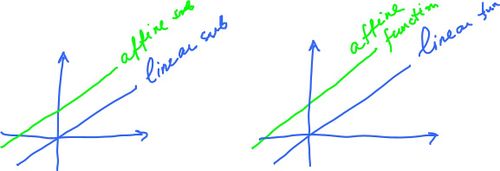This site is being phased out.
Affine function
There is some confusion about the relation between linear and affine functions. In fact, in introductory calculus the term "affine" is never used. Everything with graph a straight line is a linear function.
Function f: ℝ → ℝ is a linear function only if has the form:
f(x) = mx.
In other words, here each x is multiplied by the same number. That's a linear procedure! But mx + b is not.
Let's look at the properties of a function of this kind.
Addition is preserved under f:
If f(x) = X and f(y) = Y, then f(x + y) = X + Y.
Here x + y is the input and X + Y is the output of f.
Let's instead consider
f(x) = 3x + 1,
then
f(x + y) = 3(x + y) = 3x + 3y + 1; f(x) + f(y) = 3x + 1 + 3y + 1 = 3x + 3y + 2.
These functions are not equal! Thus 3x+1 does not preserve addition, so it’s not linear.
Scalar multiplication is preserved under f:
If f(x) = X, then f(αx) = αX.
Instead consider
f(x) = 3x + 1,
then
f(2x) = 3(2x) + 1 = 6x + 1; 2f(x) = 2(3x + 1) = 6x + 2.
These functions are not equal!
Example. Consider
f(x) = 3x + 1.
Addition is preserved if under f:
x → X and y → Y ⇒ x + y → X + Y (input) (output)
But:
f(x + y) = 3(x + y) + 1 = 3x + 3y + 1 f(x) + f(y) = 3x + 1 + 3y + 1 = 3x + 3y + 2 (the functions are not equal)
Thus, 3x + 1 does not preserve addition, so it is not linear.
Scalar multiplication is preserved if under f:
x → X ⇒ αx → αX
But:
f(2x) = 3(2x) + 1 = 6x + 1, 2f(x) = 2(3x + 1) = 6x + 2 (the functions are not equal).
more...
